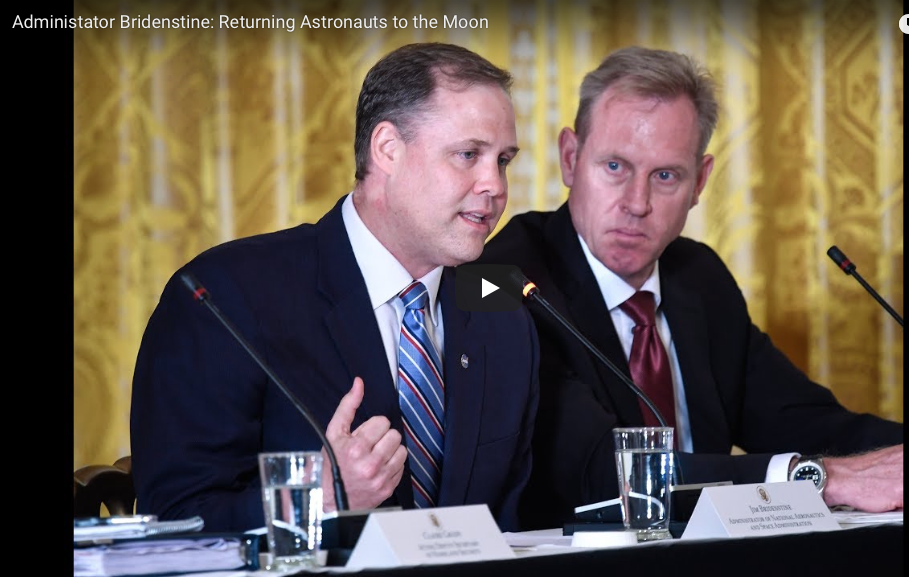President Donald J. Trump has signed the Space Policy Directive – 3 directing the United States to lead the management of traffic and mitigate the effects of debris in space. The Directive is shown below, as well as comments from Jim Bridenstine, NASA Administrator who said,
“NASA strongly supports the White House’s continued bold direction in forging a sustainable and focused space policy that strengthens American leadership. It was my honor today to represent the agency at the National Space Council, where the President announced Space Policy Directive-3 – which will guide critical and much-needed progress for space traffic management.

NASA Administrator Jim Bridenstine delivers remarks during a meeting of the National Space Council in the East Room of the White House, Monday, June 18, 2018, in Washington. Chaired by the Vice President, the council's role is to advise President Donald J. Trump regarding national space policy and strategy, and review the nation's long-range goals for space activities. Credits: NASA TV
“SPD-3 builds on our continued progress implementing SPD-1, which is galvanizing American space leadership by returning to the Moon with commercial and international partners, and SPD-2, which will create regulatory certainty for entrepreneurs to raise capital to grow the American economy in space.
“As we continue to thrive in space, we also have more people launching to orbit, and an increasingly complex universe of satellites overhead. SPD-3 provides guidelines and initiatives to ensure that America is a leader in providing a safe and secure environment as space traffic increases. Common sense space situational awareness and traffic management will be good for our economy and will help provide a more stable environment for the burgeoning space economy.
“Reducing the growing threat of orbital debris is in the interest of all nations, and NASA looks forward to working with the National Space Council, the Department of Commerce and other partners on a path forward. SPD-3 and the directives that preceded it, along with the President’s enthusiasm for our nation’s innovative work, are providing a strong foundation for our nation to once again do the big things that will shape a bright future for all of us in space.”
Space Policy Directive – 3 provides guidelines and direction to ensure that the United States is a leader in providing a safe and secure environment as commercial and civil space traffic increases. As space becomes increasingly contested, the demand for the Department of Defense (DoD) to focus on protecting U.S. space assets and interests also increases. Simultaneously, the rapid commercialization of space requires a traffic management framework that protects U.S. interests and considers the private sector’s needs.
The new Directive seeks to reduce the growing threat of orbital debris to the common interest of all nations.
- The Directive articulates the policy of the United States to pursue and utilize both Government and commercial sector technologies to track and monitor space debris.
- The Directive requires updates to the U.S. Orbital Debris Mitigation Standard Practices and new guidelines for satellite design and operation.
The new Directive sets guidelines for the United States to manage space traffic more effectively by spearheading new data sharing initiatives.
- The United States should continue to provide basic space situational awareness data and basic space traffic management services free of direct user fees.
- The Department of Commerce will make space safety data and services available to the public, while the Department of Defense maintains the authoritative catalogue of space objects.
The United States will maintain and expand its leadership in space by increasing its capabilities and developing standards and best practices. This effort will:
- Improve space situational awareness data standards and information sharing;
- Leverage U.S. standards and best practices to shape international norms; and
- Streamline processes and reduce regulatory burdens that inhibit commercial growth, enabling the U.S. commercial sector to lead the world in space.
The new Space Policy Directive builds on the President’s efforts to reinstate the United States leadership role in space.
- On May 24, 2018, the President signed Space Policy Directive – 2 to reform United States commercial space regulatory framework, seeking to ensure our place as a leader in space commerce.
- On March 23, 2018, President Trump unveiled a National Space Strategy that laid out an approach to ensuring that the United States is strong and competitive in the space environment.
- On December 11, 2017, the President signed Space Policy Directive – 1, instructing NASA to return United States astronauts to the Moon, followed by human missions to Mars.
- On June 30 2017, President Trump signed an Executive Order reviving the National Space Council for the first time in 24 years.

